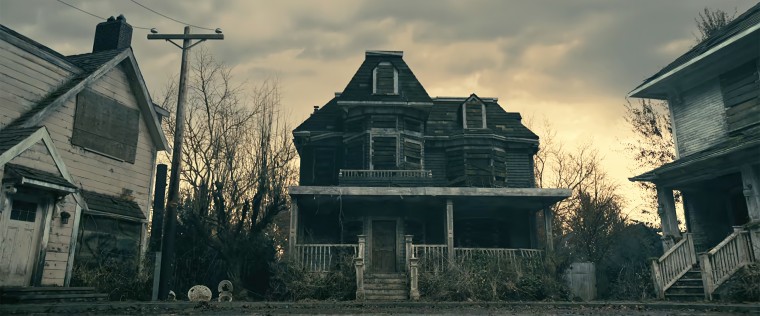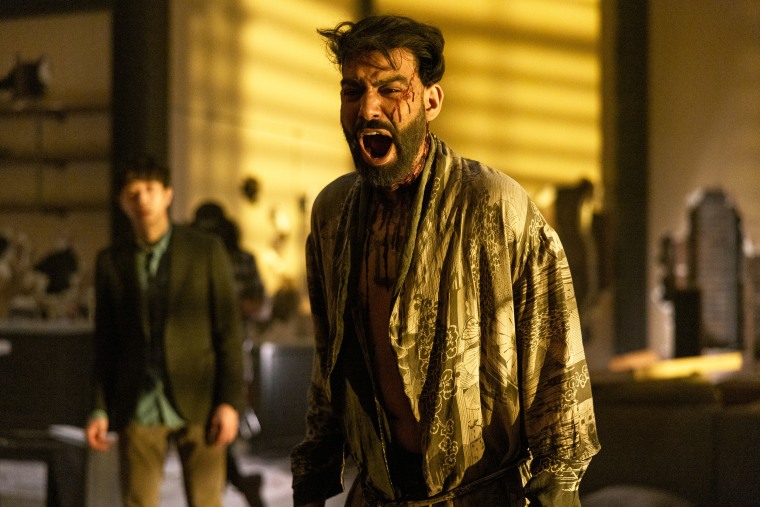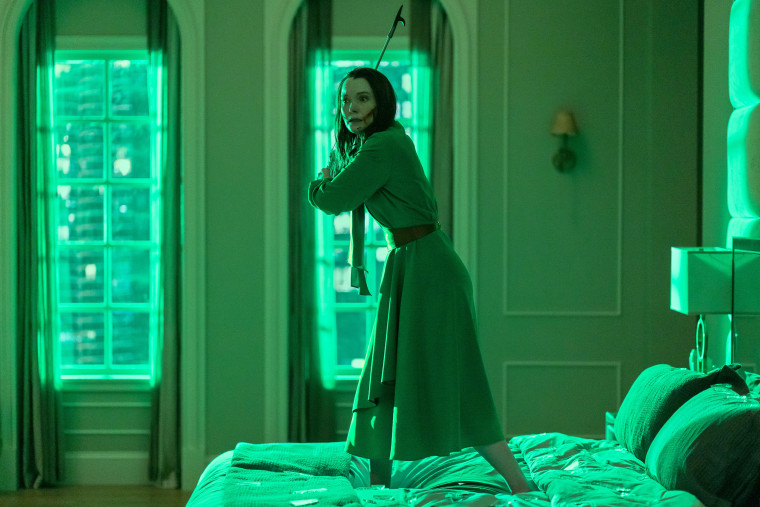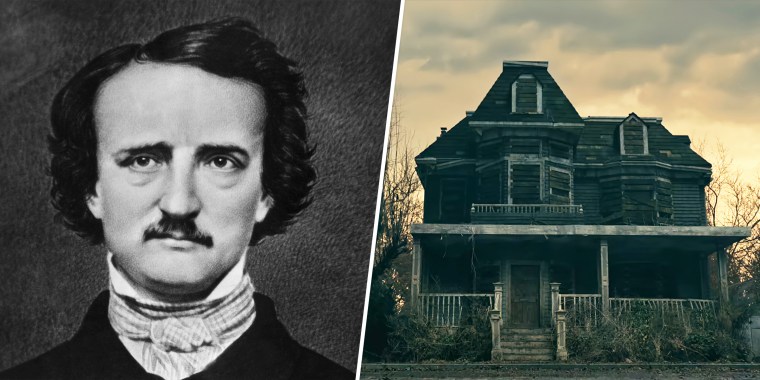Warning: This story contains spoilers for "The Fall of the House of Usher."
Michael Flanagan’s chilling new series “The Fall of the House of Usher” is an homage to Edgar Allan Poe, from the reference in the title and on.
A poet at first, Poe began publishing short horror stories in the early 1830s, with standouts like “The Tell-Tale Heart,” “Masque of the Red Death,” “The Black Cat,” “The Pit and the Pendulum,” “The Gold-Bug” and “The Murders in the Rue Morgue.”
The Flanagan show mines Poe's canon, from deep cuts to English curricula staples, to inform plot points, character names, episode titles and more.
Read on for the Edgar Allan Poe Easter eggs you might have missed in “The Fall of the House of Usher.”
What is Poe’s ‘The Fall of the House of Usher’ about?
Poe's story “The Fall of the House of Usher” provides the TV show with its narrative structure.
In both, a sick Roderick Usher tells his story to another person. Flanagan recasts Poe's unnamed narrator as investigator Auguste “Auggie” Dupin. From there, the narrator comes to learn about the Usher family's secrets and Roderick's relationship with his twin sister Madeline.
The “dark, dull” house that winds up at the center of the miniseries immediately resembles that of the one Poe describes in his story. As to how the Ushers came to live in that home? Though Poe keeps it vague, Flanagan provides backstory (lots).

The major resemblance to the short story doesn't truly become clear until the end of the show, however.
In Poe's work, Roderick's twin sister Madeline has an unexplained disease that causes her limbs to stop working. Roderick buries his sister under the home — without the help of the narrator.
The show has a twist. Madeline's limbs stop working because Roderick poisons her drink, then buries her (and replaces her eyes with blue gemstones, modeled after an Egyptian royal burial tradition).
Just as Roderick and his guest realize Madeline was buried alive, she bursts in to the room. Madeline kills her brother with her last breath in both works — through strangulation on the television show and through fear in Poe's story.
Similar to Poe's work, Auggie runs out into the street as the House of Usher finally collapses.
Poe references in each episode
“A Midnight Dreary”
The first and last episodes’ titles refer to one of Poe’s most famous literary works, “The Raven.”
Roderick and Madeline’s mother, Eliza, shares the same name as Poe’s biological mother and the middle name of his cousin, Virginia Eliza Clemm Poe, who he married.
Eliza’s cruel boss, Mr. Longfellow, was likely named after Henry Wadsworth Longfellow, a poet whom Poe showed overt disdain and, at one point, accused of plagiarism.
In the opening episode, the two children accidentally bury their mother alive, a theme in Poe’s works. Eliza escapes her grave, however, and strangles her boss to death — a murder similar to the ending of Poe’s “The Fall of the House of Usher,” and the show itself.
“The Masque of the Red Death”
The second episode borrows from Poe's 1842 story "Masque of the Red Death."
In that story, Prince Prospero — described as “happy and dauntless, and sagacious” — ignores the people around him dying of a mysterious illness called the “Red Death.” Prince Prospero is similar to Roderick’s son Prospero Usher in the show, who is more interested in sustaining his lavish lifestyle than grappling with how it was earned.
Both Prosperos throw a doomed party. Poe's Prospero has a masquerade in a massive abbey, where guests can escape from the plague outside. They walk though seven color-coded rooms (symbolizing stages of life), but are too afraid to enter the eerie last room. A skeletal figure arrives, beckoning Prospero and eventually the other guests to that room, where they contract the Red Death.

Flanagan's version has a mysterious red room. There, a masked and cloaked Verna, similar to the figure in the short story, seduces Prospero. She offers him an escape from of his doomed path, which he doesn't take.
Both stories end in his death. In Flanagan's show, it's not by Red Death, but by a sprinkler filled with acid. Themes of indifference and arrogance ultimately cost Propsero his life.
“Murder in the Rue Morgue”
The series’ third episode was inspired by Poe’s 1841 release “Murder in the Rue Morgue.”
The 1841 original was notably the first modern detective story, according to the Poe museum, with leading man C. Auguste Dupin later serving as the inspiration for Sherlock Holmes.
As in the show, C. Auguste is an investigator, but the short story follows his research into the violent murders of Madame L’Espanaye and her daughter Camille. C. Auguste finds that the murders were caused by something non-human — an escaped orangutan who scaled their Rue Street home and killed them.
In Flanagan's short story, Roderick's daughter — named Camille L'Espanaye — is killed by a chimpanzee.
“The Black Cat”
Both the short story and the episode “The Black Cat” follow the main character’s descent into madness, though initially appearing sane — a theme found in other Poe works, such as “The Tell-Tale Heart.”
In the show, Napoleon Usher blacks out one night and suspects he stabbed his partner's cat, Pluto, to death. This is similar to Poe's version, when the main character's excessive drinking leads him to kill his wife's cat. In both stories, he adopts a similar looking cat to make up for his guilt.
The new cat begins to torture both main characters. The narrator in Poe’s story attempts to kill the look-alike, but ends up murdering his wife with an axe when she gets in the way instead. He then hides her body in the damp walls of his home. After the cat lets out a meow from within the walls, police discover her corpse ... and the cat sitting on her head.
Flanagan’s “House of Usher” pays homage to that spooky final image by showing Verna seemingly dead and trapped in the walls with the cat sitting atop her head.

Because Poe used an unnamed narrator in the horrific tale, the Usher son’s name was likely inspired by another work, “The Spectacles,” where the main character’s name was originally Napoleon Bonaparte Froissart.
“The Tell-Tale Heart”
Both the fifth episode of the series and the short story feature a main character driven mad by guilt.
In Poe’s 1843 “The Tell-Tale Heart,” a narrator is so deeply bothered by an old man’s pale blue, “vulture-like eyes” that he kills him and hides his remains in the floorboards. From then on, he hears the sound of a heartbeat emanating from the burial site. He finally confesses.
Victorine Usher, Roderick's daughter, accidentally kills her partner Alessandra following a fight about their medical device. She, too, is haunted by a clicking noise. Soon, we see what it is: Alessandra's corpse, propped up, with the medical device wrapped around her heart.
Notably, the center of the medical device resembles that of a “vulture-like eye” in Poe’s original work.
Unlike the story, Victorine ends up driving herself mad to the point of stabbing herself to death. In both versions, however, it could be said their descent into madness ultimately led to their demise.
Poe’s “The Tell-Tale Heart” also uses an unnamed narrator, but the Usher daughter’s name could have been inspired by Victorine Lafourcade of the writer’s 1844 story, “The Premature Burial.” This story is focused on being buried alive and later rescued.
“Goldbug”
Poe’s “The Gold-Bug” is focused around William Legrand, who could have inspired Flanagan’s character Tamerlane’s wife, Billy.
After William loses his family's fortune, he's bitten by a golden beetle, which leads to his discovery of a secret message and hidden pirate treasure.
The show's sixth episode doesn't take on the same plot line, but seems to follow some of Poe's poem "Tamerlane," the namesake of the second eldest Usher child. The poem tells of a conqueror's deathbed confession, where he admits to prioritizing power over love. Similarly, in the show, Tamerlane chooses her lifestyle brand Goldbug over her husband.

“The Pit and The Pendulum”
Poe's "The Pit and The Pendulum" ends on a hopeful note. The show, one should note, does not.
In Poe's version, a prisoner during the Spanish Inquisition narrowly escapes death. But Frederick Usher isn't so lucky; he's killed by a pendulum.
The narrator in Poe’s “The Pit and The Pendulum” doesn’t have a name, but the eldest Usher child was likely inspired by Frederick von Metzengerstein in the writer’s 1843 work, “Metzengerstein.”
“The Raven”
“The Raven” is a character in the Netflix show. Verna is present at all the characters’ deaths, and her name is an anagram for “raven.” She is a harbinger of death.
“She isn’t human. You could say she is the executor of fate or karma,” Carla Gugino told Netflix of her character.
Poe’s poem “The Raven” tells the tale of a man dealing with the grief of lost love Lenore.
The man’s thoughts are interrupted by a raven at his window. The raven has one word to say: “Nevermore.” The word implies that nothing will change for our narrator and that grief is inescapable.
In Flanagan’s show, Roderick Usher grapples with the death of his innocent granddaughter, Lenore. At one point, Roderick narrates Poe's famous work.
Family member's names
Nearly all the names in the show hold some connection to the author, starting with Roderick and Madeline, who are the twins in Poe's “Fall of the House of Usher.”
Poe’s 1835 poem “Morella” likely inspired the name for Frederick’s wife and Lenore’s mom, Morelle. Meanwhile, Arthur Pym’s name could have been influenced by Poe’s “The Narrative of Arthur Gordon Pym of Nantucket.”
Though they don’t share the same name, Roderick’s 22-year-old wife Juno could be a connection to Poe’s own young wife, cousin Virginia Eliza Poe, whom he married when she was 13 and he was 27. Solely based on her name, however, Juno could have also been a reference to the writer’s poem “Eureka,” which mentions Juno.
Victorine’s girlfriend, Alessandra Ruiz, was likely based on one of the characters in Poe’s 1835 unpublished play “Politan.” As for Rufus Wilmot Griswold, the CEO of Fortunato who acts as a pain to Roderick and Madeline? He takes on the name of Poe’s longtime critic.
In another Poe reference, Fortunato’s money-making drug Ligadone was likely inspired by the 1938 tale, “Ligeia.” The story, which has a central theme focused around the inevitability of death, follows a woman named Rowena, who originally died from an illness but was resurrected as Ligeia.

The finale is based on another short story
The finale has elements of Poe's “The Cask of Amontillado.”
In the story, a man named Montresor seeks revenge on another man named Fortunato, Flanagan's title for the family's pharmaceutical company. Montresor gets Fortunato, who is dressed as a jester, drunk on wine and the two venture into the catacombs. There, he buries him alive in the walls.
Flanagan's version sees Roderick and Madeline go to a Fortunato company party and gift Rufus, who is also dressed as a jester, poisoned wine called Amontillado. As he starts to feel the effects, Madeline seductively takes him to the basement. There, she and her brother bury him alive.
After all, if we learned anything from this deep dive into Poe's works, it's that it wouldn't be a Poe story if someone didn't end up buried alive, or in the floorboards, or in the walls.

